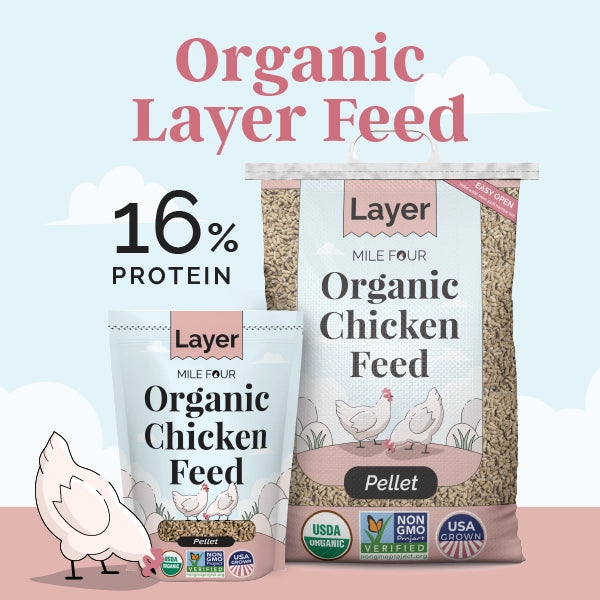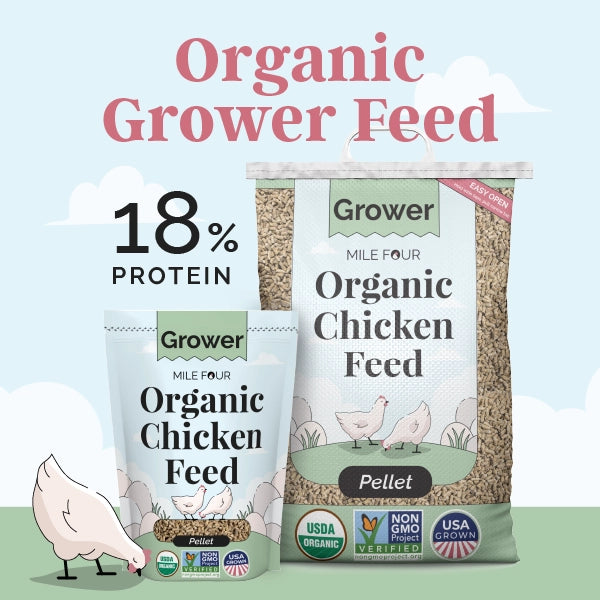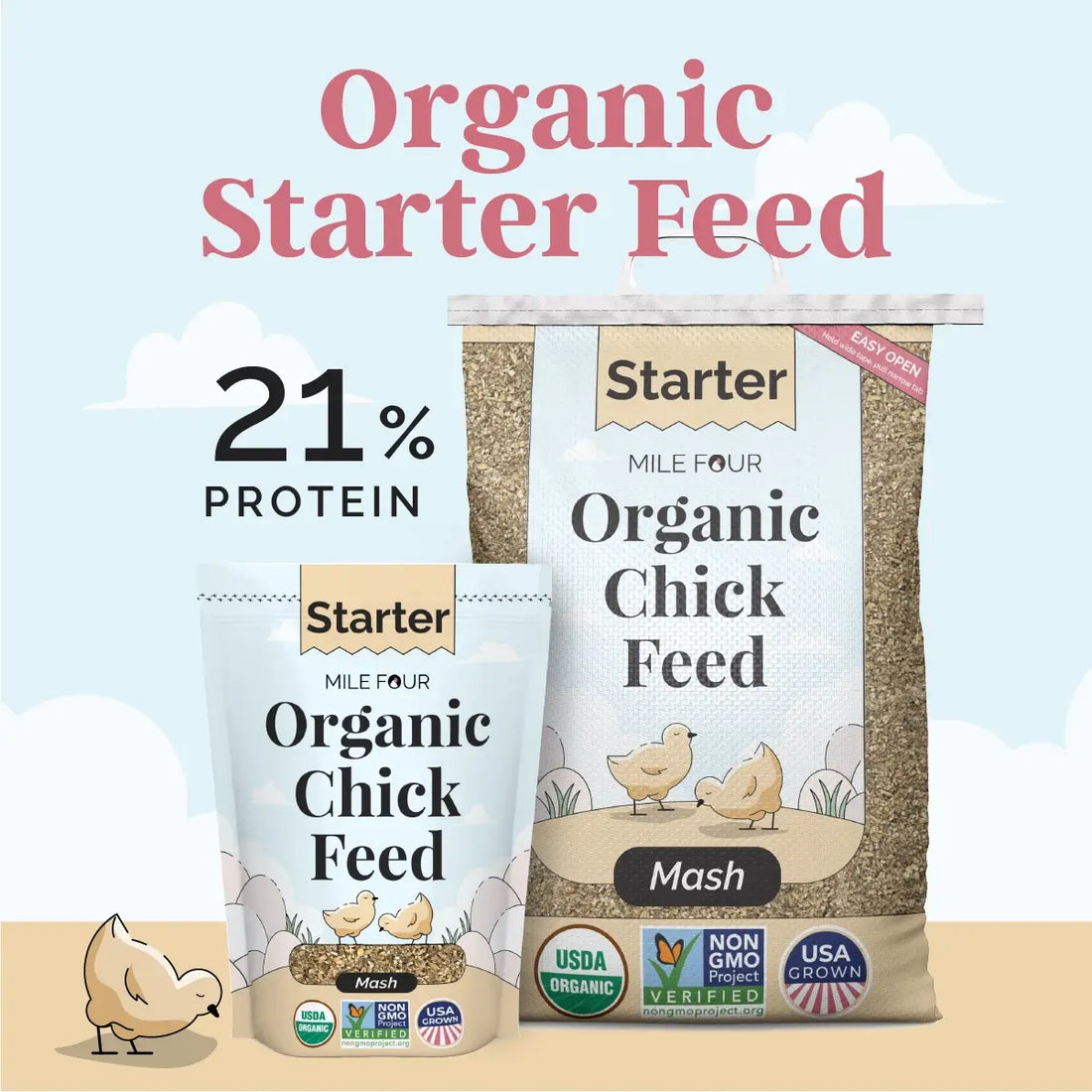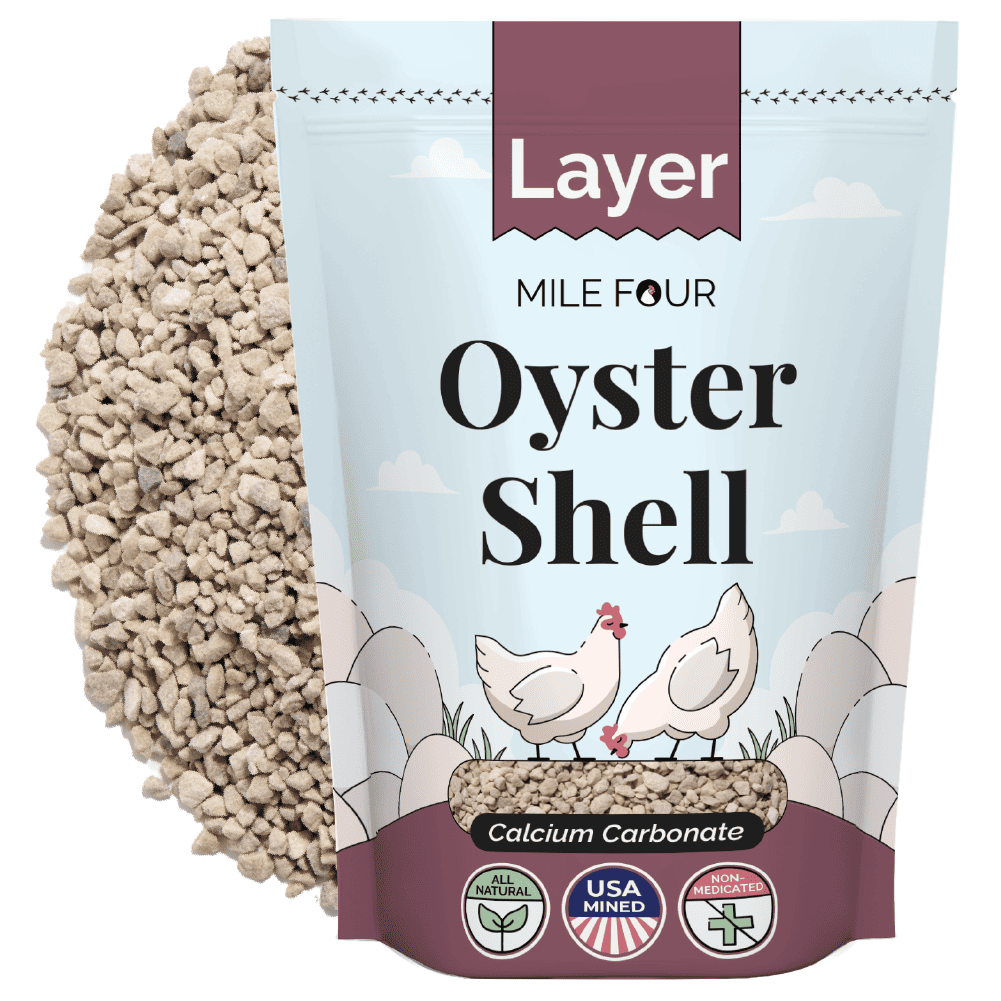Not only are Rhode Island Reds one of the most successful breeds in the world, but they are also the state bird of Rhode Island! That’s a Mile Four first!
Known to be extremely healthy and require a minimal amount of care, these birds are a perfect addition to any backyard flock, so let’s get to it!
Quick Rhode Island Red Facts
| Origin | USA |
| Colors | Dark Red |
| Weight | 6.5 - 8.5 lbs. |
| Lifespan | 8+ yrs. |
| Rate of Lay/yr. | 250 - 300 eggs |
| Egg size | Large |
| Egg Color | Light brown |
| Heat Hardy | Yes |
| Cold Hardy | Yes |
| Broodiness | Infrequent |
| Disease Susceptibility | Mites & lice |
| Temperament | High-spirited |
| Beginner friendly | Yes |
| Cost to purchase | $4.50 |
Quick Jump
Chapter 1: Appearance of Rhode Island Red Chickens
Chapter 2: History of Rhode Island Red Chickens
Chapter 3: Rhode Island Red Chickens for Sale
Chapter 4: Rhode Island Red Chicken Egg Laying
Chapter 5: Rhode Island Red Chicken Health Issues & Care
Chapter 6: Rhode Island Red Chicken Temperament
Chapter 7: Feeding Rhode Island Red Chickens
Chapter 8: Coop & Run Size for Rhode Island Red Chickens
Chapter 9: Pros & Cons of Rhode Island Red Chickens
Chapter 10: Rhode Island Red Chicken FAQs
Chapter 1: Appearance of Rhode Island Red Chickens
A chicken with a very distinctive look, you won’t be mistaking the Rhode Island Red for any other chickens in your flock.
They have a rectangular body in most cases that many describe as “bricky” mainly due to their size mixed with their color.
Their feathers are quite hard and tight, held together compactly due to their lineage from the Malay breed, which holds the same trait.
Rhode Island Red combs and wattles will be a bright red, very much like the typical “chicken look” in animated television and movies, and they have yellow skin below their beautiful plumage.
The most prevalent of the Rhode Island Red breed has a single comb, but rose combed Red’s do exist, although they are much less common.

Share this Image On Your Site
Rhode Island Red Chicken Size
A standard Rhode Island Red hen will weigh around 6.5 lbs., while a rooster will weigh around 8.5 lbs.
Bantam Rhode Island Reds are much less popular than a standard sized hen, but they do exist, and weigh a tiny 2 lbs.!
Rhode Island Red Colors
While the colors of the Rhode Island Red can range anywhere from a very light red (brick like) to almost completely black, most Reds will be a chestnut red/reddish brown.
Nine times out of ten, their tail will be somewhat black or completely black, and you may find some black feathers on their wings too.
Chapter 2: History of Rhode Island Chickens
A true American, the Rhode Island Red was bred in, well, Rhode Island!
It was bred selectively from eastern birds such as the Cochin, the previously mentioned Malay (where they get their plumage from) as well as the Java.
Rhode Island Red Chickens Journey
They were first shown under their present day name in 1895, and were admitted to the American Poultry Association’s Standard of Perfection in 1904.
Fun fact - the Malay bird (at least a photo of it) that was first used to start the Rhode Island Red breed is currently preserved in the Smithsonian!
Initially, the bird was dual-purpose, providing meat and eggs to their owners, but it has since been bred specifically for its egg laying abilities.

Share this Image On Your Site
Chapter 3: Rhode Island Red Chickens for Sale
Rhode Island Red Chicken Hatcheries
Like most birds, the Rhode Island Red doesn’t seem to have hatcheries specific to the breed.
They are, however, readily available at most of the popular online hatcheries, and if you live near one you should easily be able to find them.
A Rhode Island Red chicken will cost around $3.50 per bird if you were to buy more than 100, but only $4.50 per bird if you were to buy between one and five.
Availability of Rhode Island Reds usually starts around the end of January each year, and stretches through to October, which is quite typical of most chicken breeds at most hatcheries.
You’ll want to note that if it is your first time buying chicks online, they will be shipped to you with enough food to last the trip.
You will have to pick them up at the Post Office and have a member of staff watch you physically open the box to ensure they were delivered in good shape.
Should you have any problems with your delivery, most hatcheries will be happy to send you a replacement shipment.
If you need more information on purchasing chickens from a hatchery, read our Best Hatcheries Guide here!
Chapter 4: Rhode Island Red Chicken Egg Laying
Rhode Island Red chickens are one of the top performing breeds when it comes to egg production.
Most owners have Reds for this very reason, and you’ll be hard pressed to find another chicken to add to your flock that can keep up with the haul that a Rhode Island Red will give you.
Modern Rhode Island Reds were bred specifically for their egg production.
Their eggs are a light or dark brown, and are heavier than the average store bought egg.

Share this Image On Your Site
Rhode Island Red Chicken Rate of Lay
Your Rhode Island Red hens will lay anywhere between five and six eggs a week.
This translates to upwards of 300 per year!
You’ll definitely never go needing eggs in the kitchen again should you have a few of these guys in your backyard.
Your Reds will also withstand the cold and lay nearly all year, meaning even in the colder months you’ll have eggs on deck when other breeds will stop laying.
Rhode Island Red Chicken Broodiness
Rhode Island Reds have been specifically bred for their egg production, meaning that broodiness has been mostly bred out of them.
That’s not to say that they won’t become broody from time to time, and they have been known to occasionally.
When broody, Rhode Island Reds are quite diligent about sitting in their nest.
They are unlikely to grab other birds’ eggs like Silkies do.
If the eggs they are sitting on are fertilized and eventually hatch, Reds will make excellent mothers. They are protective and will ensure that their young will grow healthy and happy on their own.
If your Red goes broody and you’re reliant on their eggs, placing them into a wire cage (like a dog kennel) will take care of their broodiness pretty quickly.
Chapter 5: Rhode Island Red Chicken Health Issues & Care
Rhode Island Red chickens are well known for their hardiness.
They will easily be able to withstand a wide range of temperatures, from below freezing to upwards of 100F.
As they are great foragers, they often fend for themselves and won’t need much in the way of care.
With any breed, however, they will be susceptible to lice and mites if you don’t stay on top of cleaning them from time to time, especially in the wetter and muddier months.
If they have the necessary shelter, a clean place to live, forage and socialize, and a great owner like yourself, they’ll be just fine!
Chapter 6: Rhode Island Red Chicken Temperament
Rhode Island Reds are a very curious bird, and probably the first one you’ll see in the morning when you open up the coop.
They’ll want to be the first to grab feed or treats too, so you might not want to make a habit of bringing them treats first thing in the morning.
This curiosity can border on noseyness, as they’ll likely follow you around whenever you’re outside in an attempt to see what you’re doing.
They have an ulterior motive, however, since they are most likely only following you around to see what they can get out of it.
Rhode Island Red Chickens in the Pecking Order
Reds will sit relatively high in the pecking order.
Despite their friendly disposition, they’ll be a mid to high level bird when it comes to flock hierarchy.
That’s not to say they’ll be mean birds, but they have been known to pick on very docile breeds from time to time.
You’ll need to be careful welcoming a Rhode Island Red into your flock if you already have breeds such as Silkies and Polish hens.
Chapter 7: Feeding Rhode Island Red Chickens
Rhode Island Red chickens don’t have any specific dietary needs, meaning you’ll be fine feeding them what you feed the rest of your flock.
Chicks will need a 21% Starter Feed, which you can purchase right here! They will eat Starter from the day they’re born until they are around 8 weeks old.
Once they’re 8 weeks old, you’ll want to switch them to a 18% Grower Feed, which you can also purchase right here!
Grower is fed to pullets from 8 weeks all the way up to when they lay their first egg.
Once their first egg is laid, you’ll need to switch them to a 16% Layer Feed.
You guessed it. You can purchase Layer Feed right here!
This Layer Feed will be the main source of nutrition for the rest of their lives, but you can add in treats like Scratch, or Oyster Shell to aid in egg production.
Chapter 8: Coop & Run Size for Rhode Island Red Chickens
While not being the biggest bird in the world, you’ll want to make sure you have a little more space per Red than normal.
A space of four square feet per bird should be sufficient in your coop.
This is because of their assertiveness and their position on the pecking order.
If you don’t give each Rhode Island Red enough space, things can go from bad to worse pretty quickly inside the coop.
They won’t need much perch space, especially in the winter since they like to cuddle, but they will stretch out in the summer months to stay cool, so up to 10 inches of perch space per bird is ideal.
A backyard with a fence would be perfect for Rhode Island Reds.
They like to roam and forage, so around 15 square feet per bird is the optimal number to allow them to stretch their legs and wings.
Despite their love of the outdoors, they seem to do more than fine inside the coop too, so you won’t have to worry about their volume levels once you close the coop for the night, or rush them inside due to a predator problem.
As for their nesting boxes, they will need a standard 12in. x 12in. space to lay.
Any less than this and they may opt to lay elsewhere in a non-designated nesting area.
Any larger than this and they’ll start to nest together, which will lead to broken eggs.
Given their proclivity for laying, you definitely won’t want to lose out on their wonderful egg laying skills!
Chapter 9: Pros & Cons of Rhode Island Red Chickens
| Pros | Cons |
| Happy-go-lucky personality | Loud |
| Excellent egg layers | Sometimes lower down on the pecking order |
| Great beginner hen | Can be skittish |
| Very resistant to most diseases | Escape artists/curiosity can get the best of them |
| Very friendly for the most part | Can become aggressive if they don't have enough space |
Chapter 10: Rhode Island Red Chicken FAQs
Q: How many eggs will a Rhode Island Red hen lay per year?
A: A Rhode Island Red hen will lay up to 300 eggs per year
Q: What color are Rhode Island Red eggs?
A: Their eggs are a light or somewhat dark brown
Q: Are Rhode Island Red chickens aggressive?
A: If they are not given enough space in the coop, or you have a mixed flock with very docile birds, they can become aggressive
Q: How often do Rhode Island Red hens go broody?
A: Not very often at all, but when they do, they are very diligent and will make excellent mothers if they hatch chicks
Q: Are Rhode Island Red chickens susceptible to any diseases?
A: They are very hardy birds, and will only be susceptible to lice and mites if you don’t keep them clean
Summary
Rhode Island Reds are wonderful birds to have in your flock.
They will fend for themselves, get much of their nutrition from foraging, and will love you right back (especially if you give them treats).
You won’t need to watch out for many diseases, and if you keep them clean on a regular schedule you won’t have to worry about lice and mites either.
They will lay upwards of 300 eggs per year in a beautiful brown color.
Watch out for their potential aggressiveness with smaller, docile birds, however.
Overall, the Rhode Island Red will not disappoint if and when you introduce them into your flock!


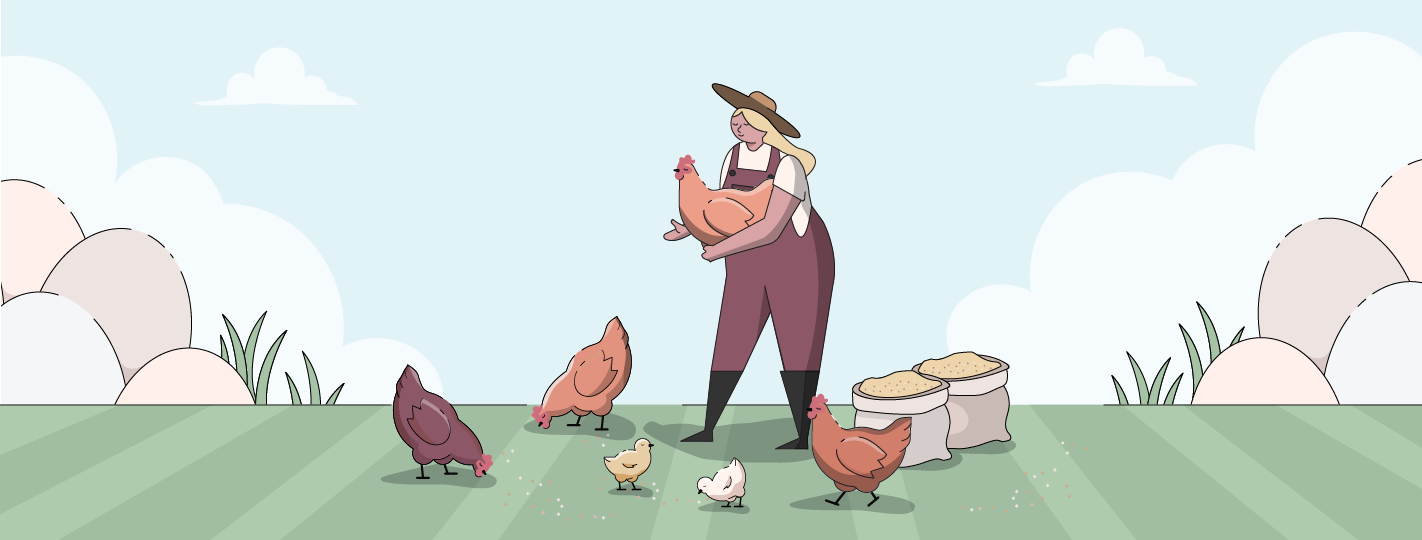

![Winter Chicken Care | Ultimate Guide [2026]](http://milefour.com/cdn/shop/articles/Mile_Four-Content-15_e1067340-1a72-4632-83f5-c66d9a2158d9.png?v=1768418185&width=1500)

